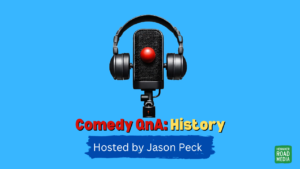For those of you who really want to learn stand-up comedy, or humorous speaking, I wanted to share with you a recent newsletter that I received from my comedy colleague Steve Roye. His newsletter is the “Comedy Success Professional Newsletter” (CSPN) and is offered specifically for new and experienced comedy professionals.
If you haven’t done so already, read my review of The Fast Start Guide review, then get your own copy and sign up to Steve’s newsletter. You won’t regret it.
I wanted to re-post an extract of one his newsletter’s here and supply some of my own thoughts alongside Steve’s (mine appear in italics). It’ll also help you get a taster of the quality of information that he provides that helps you learn stand-up comedy and techniques for creating humorous material.
In this particular newsletter Steve was asked whether he makes eye contact with someone when he made them laugh. Hope you enjoy it:
—Start of newsletter extract—
“When you make people laugh in everyday life without “thinking” about it… Were you making eye contact with the person you made laugh at something you said?It should go without saying that making someone laugh while talking on the phone doesn’t count….”
See I think that it does count. A laugh is a laugh, surely? If you can make a note of exactly what you said (see further down this post) then I think you can certainly try it out. Obviously making eye contact AND being in the room’s best. But why not experiment?
“But in person… While there are no absolutes, I would be willing to bet that MOST of the time, you were looking directly at the person you made laugh.
In other words, you were making direct eye contact when laughter “struck” the other person out of the blue. While this may not seem like a big deal now, trust me — it’s huge and can be directly applied to the comedy stage or podium.”
Yup, have done that. Whilst I haven’t tried out entire bits that have been created in everyday conversation, the odd line here and there has definitely worked when translated to the stage.
“For now, just keep track and make a mental note on whether or not you make direct eye contact when you make someone laugh in casual conversation…”
I always try to carry an ideas book around with me. Think the best thing might be to carry around a small dictaphone, so then you can record entire bits that get created in conversation and the correct wording and inflection can be captured too.
But before I go there, I want you to understand what I am trying to accomplish in this series. First, I DON’T want you to be “on the lookout” for anything in advance. Otherwise, you won’t simply be “you”.”
Absolutely. I’m usually too busy doing the funny that I forget to write it down even after the event. But you should definitely write the ideas and lines down AFTER the event. Not during.
“You will end up being some sort of analytical wiene that won’t get any laughs…”
Hmm, already an analytical weine (sic). Just happen to get the laughs too. Which is a nice bonus 🙂
“What I DO want you to do is pay attention to some things AFTER you have made someone laugh without
“thinking about” what you did to make them laugh in the first place.
In other words, you don’t even begin to think about what happened until after it has happened — the trigger here is…
You made someone laugh under “ordinary”, everyday circumstances, just being yourself. Only then do you start thinking about what happened…”
—End of newsletter extract—
Absolutely, although sometimes I think the difficulty can arise in situations where you make people laugh about, say, colleagues in a work environment. So your colleague is laughing at another colleague’s expense.
In this scenario I’m not sure how that would translate into a platform situation. Not without a lot of explanation at least. In-jokes are probably best avoided, especially ones which are derogatory to your fellow employees.
What you have to remember is that if you’re giving a talk or presentation at work you are being watched by people. People love to be entertained and the mechanisms for making someone laugh in a bar, by the water cooler, as a stand-up comedian or during a presentation are no different.
Obviously, what can happen is that you feel different during a presentation. People expect different things, react in different ways and there can also be a different atmosphere in the room. There can be a certain amount of reservation amongst the participants. But they are still able to laugh, even if they might not be readily able.
What is worth doing, then, is finding personal stories that relate to the presentation or talk that you’re giving. This is also a useful starting point if you want to learn stand-up comedy. You cannot just present the facts or statistics, you have to find a way to personalise them through examples and stories. Which you can then use to bring out your own sense of humour.
That’s where your own sense of humour can come into play. If you’re able to keep a note of the funny things that you say…
And those funny lines are relevant to the topic of your speech…
Then you can definitely incorporate them. If your a speaker, you’re not setting out to be a laugh-out-loud comedian. Don’t worry. Remove that pressure right now. What you are setting out to do is to make the points of your talk more memorable. People often remember things better when they’re laughing and being entertained.
Even if you are setting out to learn stand-up comedy, you don’t want to pressurise yourself either. Just make sure that your stories and the humorous ideas that you capture are genuine.
What I’m talking about here goes beyond mere usage of joke writing formulas. Whilst they are very useful, you don’t have to use them in order to create humorous material for a speech or presentation. Oftentimes I’ve found that they actually get in the way of the comedy writing process.
However, they can sometimes be useful as they can help add detail and allow you to refine your funny lines and stories. So I’ll deal with them in a future post. Although, that said, I don’t even think Steve addresses them at all.
So, if you haven’t done so already, check out: The Fast Start Guide.
Update: 15th April 2009
Steve Roye now runs a blog useful for both stand-up comedians and humorous speakers called:
The Stand-up Comedy Professional
Note: There are affiliate links on this page. That means that if you make a purchase via my link I get paid a commission. It’s how I help pay the bills.




1 pings
[…] may be the best medicine, but how can we laugh at a time like this? Some […] Jason PeckMusical Impressionist Danny Gans Passes Away May 3, 2009I was surprised to hear of the passing of musical impressionist Danny Gans who was 52. […]